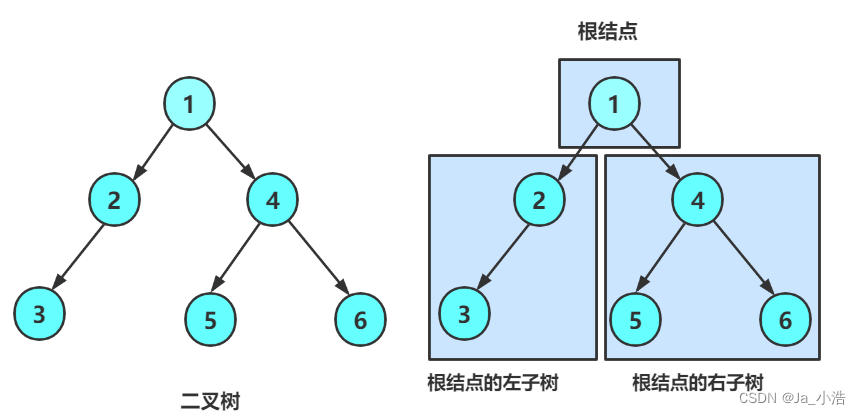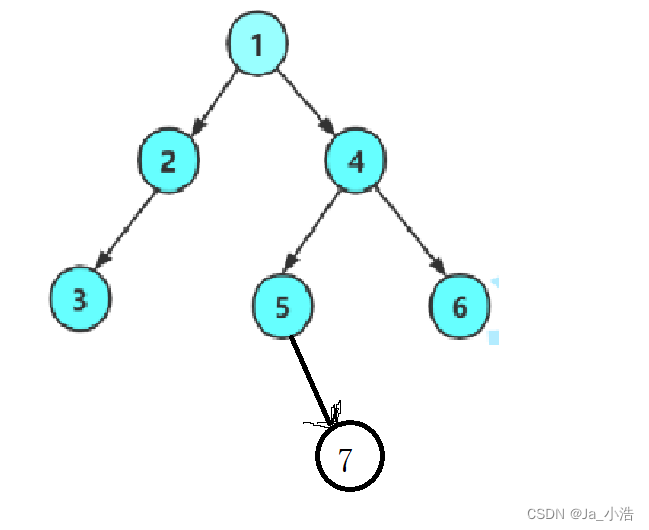【数据结构】二叉树链式结构详解
目录
1.前言
前面我们已经讲过二叉树的概念及堆的实现,而我们所学的堆其实只是二叉树的顺序结构实现,当然堆的实现只能适用于完全二叉树或者满二叉树,但如果不是完全二叉树或者满二叉树这样的结构呢?那么就必须要谈一谈二叉树的链式结构的实现了,接下来我们将对递归有着更深层次的去理解,准备好小本本吧!
2.快速创建一颗二叉树
在学习二叉树的基本操作前,需要先创建一棵二叉树,然后才能学习其相关的基本操作。
由于现在大家对二叉树结构掌握还不够深入,为了降低学习成本,此处手动快速创建一棵简单的二叉树,快速进入二叉树操作学习,等二叉树结构了解的差不多时,我们反过头再来研究二叉树真正的创建方式。
下面看代码:
typedef int BTDataType;
typedef struct BinaryTreeNode
{
BTDataType data;
struct BinaryTreeNode* left;
struct BinaryTreeNode* right;
}TreeNode;
TreeNode* BuyTreeNode(int x)
{
TreeNode* node = (TreeNode*)malloc(sizeof(TreeNode));
assert(node);
node->data = x;
node->left = NULL;
node->right = NULL;
return node;
}
TreeNode* CreateTree()
{
TreeNode* node1 = BuyTreeNode(1);
TreeNode* node2 = BuyTreeNode(2);
TreeNode* node3 = BuyTreeNode(3);
TreeNode* node4 = BuyTreeNode(4);
TreeNode* node5 = BuyTreeNode(5);
TreeNode* node6 = BuyTreeNode(6);
TreeNode* node7 = BuyTreeNode(7);
node1->left = node2;
node1->right = node4;
node2->left = node3;
node4->left = node5;
node4->right = node6;
node5->right = node7;
return node1;
}
注意:上述代码并不是创建二叉树的方式,真正创建二叉树方式后序详解重点讲解。
在开始二叉树的基本操作前,先回顾一下我们二叉树的概念,二叉树:
- 空树
- 非空:跟节点,根节点的左子树,根节点的右子树组成的。

所以说二叉树可以更好的理解递归,二叉树的概念就说明二叉树是递归式的,二叉树的基本操作都是递归式的。
上面我们创建的二叉树加了一个新节点,便于后面的理解。

3.二叉树的遍历
学习二叉树结构,最简单的方式就是遍历。所谓二叉树遍历(Traversal)是按照某种特定的规则,依次对二叉树中的节点进行相应的操作,并且每个节点只操作一次。访问结点所做的操作依赖于具体的应用问题。
遍历是二叉树上最重要的运算之一,也是二叉树上进行其它运算的基础。
按照规则,二叉树的遍历有:前序/中序/后序的递归结构遍历:
- 前序遍历(Preorder Traversal 亦称先序遍历)——访问根结点的操作发生在遍历其左右子树之前。
- 中序遍历(Inorder Traversal)——访问根结点的操作发生在遍历其左右子树之中(间)。
- 后序遍历(Postorder Traversal)——访问根结点的操作发生在遍历其左右子树之后。
由于被访问的结点必是某子树的根,所以N(Node)、L(Left subtree)和R(Right subtree)又可解释为根、根的左子树和根的右子树。NLR、LNR和LRN分别又称为先根遍历、中根遍历和后根遍历。
忘了更便于我们理解,我们把空也打印出来,下面就是这几种遍历方式。
3.1前序遍历
前序遍历就是
分治思想:根 左子树 右子树
根据这个思想进行遍历得到前序序列。
代码实现:
void PrevOrder(TreeNode* root)
{
if (root == NULL)
{
printf("N ");
return;
}
printf("%d ", root->data);
PrevOrder(root->left);
PrevOrder(root->right);
}
前序遍历结果:1 2 3 N N N 4 5 N 7 N N 6 N N
3.2中序遍历
中序遍历就是
分治思想: 左子树 根 右子树
根据这个思想进行遍历得到中序序列。
代码实现:
void InOrder(TreeNode* root)
{
if (root == NULL)
{
printf("N ");
return;
}
InOrder(root->left);
printf("%d ", root->data);
InOrder(root->right);
}
中序遍历结果:N 3 N 2 N 1 N 5 N 7 N 4 N 6 N
3.3后序遍历
后序遍历就是
分治思想:左子树 右子树 根
根据这个思想进行遍历得到后序序列。
代码实现:
void BackOrder(TreeNode* root)
{
if (root == NULL)
{
printf("N ");
return;
}
BackOrder(root->left);
BackOrder(root->right);
printf("%d ", root->data);
后序遍历结果:N N 3 N 2 N N N 7 5 N N 6 4 1
3.4层序遍历
层序遍历有两个版本,版本一可是直接遍历一遍二叉树并打印一行,
而版本二可以分层进行打印,一层一层的打印出数据。
对于层序遍历中的队列的使用,可以去搬来我之前写的栈和队列那一节内容的代码。
版本一:
void BinaryTreeLevelOrder(TreeNode* root)
{
Queue q;
QueueInit(&q);
if (root)
QueuePush(&q,root);
while (!QueueEmpty(&q))
{
TreeNode* front = QueueFront(&q);
QueuePop(&q);
printf("%d ", front->data);
if (front->left)
QueuePush(&q,front->left);
if (front->right)
QueuePush(&q,front->right);
}
QueueDestroy(&q);
}
版本二:
void BinaryTreeLevelOrder(TreeNode* root)
{
Queue q;
QueueInit(&q);
if (root)
QueuePush(&q, root);
int levelSize = 1;
while (!QueueEmpty(&q))
{
while (levelSize--)
{
TreeNode* front = QueueFront(&q);
QueuePop(&q);
printf("%d ", front->data);
if (front->left)
QueuePush(&q, front->left);
if (front->right)
QueuePush(&q, front->right);
}
printf("\n");
levelSize = QueueSize(&q);
}
QueueDestroy(&q);
}
4.二叉树节点个数与高度
4.1二叉树节点个数
int TreeSize(TreeNode* root)
{
return root == NULL ? 0 :
TreeSize(root->left) +
TreeSize(root->right) + 1;
}
4.2二叉树叶子节点个数
int BinaryTreeLeaf(TreeNode* root)
{
//空树 返回0
if (root == NULL)
return 0;
//左子树为空,右子树为空 是叶子,返回1
if (!root->left && !root->right)
return 1;
//递归遍历,不是空也不是叶子,分治左右子树之和
return BinaryTreeLeaf(root->left) + BinaryTreeLeaf(root->right);
}
4.3二叉树高度
int TreeHeight(TreeNode* root)
{
if (root == NULL)
return 0;
return fmax(TreeHeight(root->left), TreeHeight(root->right)) + 1;
}
一道Leetcode的一道题。
求二叉树的深度OJ链接
解题代码:
int maxDepth(struct TreeNode* root) {
if (root == NULL)
return 0;
int LeftHeight = maxDepth(root->left);
int RightHeight = maxDepth(root->right);
return LeftHeight > RightHeight ? LeftHeight + 1 : RightHeight + 1;
}
4.4二叉树第k层节点个数
int TreeLevelK(TreeNode* root, int k)
{
assert(k > 0);
if (root == NULL)
return 0;
if (k == 1)
return 1;
return TreeLevelK(root->left, k - 1) +
TreeLevelK(root->right, k - 1);
}
4.5二叉树查找值为x的节点
BTNode* BinaryTreeFind(BTNode* root, BTDataType x)
{
if (root == NULL)
return NULL;
if (root->data == x)
{
return root;
}
BTNode* ret1 = BinaryTreeFind(root->left, x);
if (ret1)
return ret1;
BTNode* ret2 = BinaryTreeFind(root->right, x);
if (ret2)
return ret2;
return NULL;
}
5.二叉树的基础oj题练习
- 单值二叉树。OJ链接
bool isUnivalTree(struct TreeNode* root) {
if(root == NULL)
return true;
if(root->left && root->val != root->left->val)
return false;
if(root->right && root->val != root->right->val)
return false;
return isUnivalTree(root->left)
&& isUnivalTree(root->right);
}
- 检查两颗树是否相同。OJ链接
bool isSameTree(struct TreeNode* p, struct TreeNode* q) {
//均为空
if(p == NULL && q == NULL)
return true;
//有一个为空
if(p == NULL || q == NULL)
return false;
//都不为空且不相等
if(p->val != q->val)
return false;
return isSameTree(p->left,q->left)
&& isSameTree(p->right,q->right);
}
- 对称二叉树。OJ链接
bool _isSymmetric(struct TreeNode* root1, struct TreeNode* root2) {
//都为空
if(root1 == NULL && root2 == NULL)
{
return true;
}
//其中一个为空
if(root1 == NULL || root2 == NULL)
{
return false;
}
//都不为空
if(root1->val != root2->val)
{
return false;
}
return _isSymmetric(root1->left,root2->right)
&& _isSymmetric(root1->right,root2->left);
}
bool isSymmetric(struct TreeNode* root) {
return _isSymmetric(root->left, root->right);
}
- 二叉树的前序遍历。 OJ链接
int TreeSize(struct TreeNode* root)
{
return root == NULL ? 0 : TreeSize(root->left) + TreeSize(root->right) + 1;
}
int* pre_order(struct TreeNode* root, int* a, int* pi)
{
if(root == NULL)
return NULL;
a[(*pi)++] = root->val;
pre_order(root->left,a,pi);
pre_order(root->right,a,pi);
return a;
}
int* preorderTraversal(struct TreeNode* root, int* returnSize) {
int n = TreeSize(root);
int* a = (int*)malloc(sizeof(int)*n);
*returnSize = n;
int i = 0;
return pre_order(root, a,&i);
}
- 二叉树中序遍历 。OJ链接
int TreeSize(struct TreeNode* root)
{
return root == NULL ? 0 : TreeSize(root->left) + TreeSize(root->right) + 1;
}
int* inorder(struct TreeNode* root, int* s, int* pi)
{
if(root == NULL)
return NULL;
inorder(root->left,s,pi);
s[(*pi)++] = root->val;
inorder(root->right,s,pi);
return s;
}
int* inorderTraversal(struct TreeNode* root, int* returnSize) {
int n = TreeSize(root);
int* s = (int*)malloc(sizeof(int)*n);
*returnSize = n;
int i = 0;
return inorder(root,s,&i);
}
- 二叉树的后序遍历 。OJ链接
int TreeSize(struct TreeNode* root)
{
return root == NULL ? 0 : TreeSize(root->left) + TreeSize(root->right) + 1;
}
int* postorder(struct TreeNode* root, int* s, int* pi)
{
if(root == NULL)
return NULL;
postorder(root->left,s,pi);
postorder(root->right,s,pi);
s[(*pi)++] = root->val;
return s;
}
int* postorderTraversal(struct TreeNode* root, int* returnSize) {
int n = TreeSize(root);
int* s = (int*)malloc(sizeof(int)*n);
*returnSize = n;
int i = 0;
return postorder(root,s,&i);
}
- 另一颗树的子树。OJ链接
bool isSameTree(struct TreeNode* p, struct TreeNode* q)
{
if(p == NULL && q == NULL)
return true;
if(p == NULL || q == NULL)
return false;
if(p->val != q->val)
return false;
return isSameTree(p->left,q->left)
&& isSameTree(p->right,q->right);
}
bool isSubtree(struct TreeNode* root, struct TreeNode* subRoot){
if(root == NULL)
return false;
if(root->val == subRoot->val)
{
if(isSameTree(root,subRoot))
{
return true;
}
}
return isSubtree(root->left,subRoot)
|| isSubtree(root->right,subRoot);
}
6.二叉树的创建和销毁
二叉树的构建及遍历。OJ链接
#include <stdio.h>
#include<stdlib.h>
struct TreeNode
{
char val;
struct TreeNode* left;
struct TreeNode* right;
};
struct TreeNode* CreatBinaryTree(char* s, int* pi)
{
if(s[*pi] == '#')
{
(*pi)++;
return NULL;
}
struct TreeNode* root = (struct TreeNode*)malloc(sizeof(struct TreeNode));
root->val = s[(*pi)++];
root->left = CreatBinaryTree(s, pi);
root->right = CreatBinaryTree(s, pi);
return root;
}
void InOrder(struct TreeNode* root)
{
if(root == NULL)
return;
InOrder(root->left);
printf("%c ",root->val);
InOrder(root->right);
}
int main() {
char s[101];
int i = 0;
while(scanf("%s",s)!=EOF)
{
struct TreeNode* root = CreatBinaryTree(s,&i);
InOrder(root);
}
return 0;
}
6.1通过前序遍历的数组"ABD##E#H##CF##G##"构建二叉树
分析:
根据前序遍历,特别要注意的是pi,控制的是数组的小标,传进来的是指针。
BTNode* BinaryTreeCreate(BTDataType* a, int* pi)
{
if (a[*pi] == '#')
{
(*pi)++;
return NULL;
}
BTNode* root = (BTNode*)malloc(sizeof(BTNode));
if (root == NULL)
{
perror("malloc fail");
exit(-1);
}
root->data = a[(*pi)++];
root->left = BinaryTreeCreate(a, pi);
root->right = BinaryTreeCreate(a, pi);
return root;
}
6.2二叉树销毁
分析:
使用后序遍历的方式来销毁。
void BinaryTreeDestory(BTNode* root)
{
if (root == NULL)
{
return;
}
BinaryTreeDestory(root->left);
BinaryTreeDestory(root->right);
free(root);
}
6.3判断二叉树是否是完全二叉树
分析:
我们知道,如果一个二叉树是完全二叉树,那么在层序遍历时,当遍历到第一个空时,如果后面的内容仍然是空的,那么这个二叉树是完全二叉树,反之则不是。
bool BinaryTreeComplete(TreeNode* root)
{
Queue q;
QueueInit(&q);
if (root)
QueuePush(&q, root);
while (!QueueEmpty(&q))
{
TreeNode* front = QueueFront(&q);
QueuePop(&q);
if (front == NULL)
break;
QueuePush(&q, front->left);
QueuePush(&q, front->right);
}
while (!QueueEmpty(&q))
{
TreeNode* front = QueueFront(&q);
QueuePop(&q);
if (front)
return false;
QueuePush(&q, front->left);
QueuePush(&q, front->right);
}
QueueDestroy(&q);
return true;
}
本文来自互联网用户投稿,该文观点仅代表作者本人,不代表本站立场。本站仅提供信息存储空间服务,不拥有所有权,不承担相关法律责任。 如若内容造成侵权/违法违规/事实不符,请联系我的编程经验分享网邮箱:chenni525@qq.com进行投诉反馈,一经查实,立即删除!